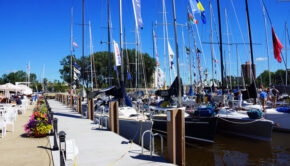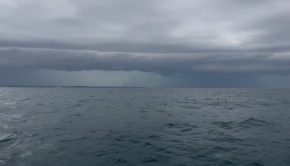Debating the physicality in sailing
Published on October 7th, 2021
In the October 2021 e-Newsmagazine of the Lake Michigan Sail Racing Federation, Commodore Sam Nedeau argues with himself about the physical demands of big and small boat racing.
I am going to attempt to settle the argument I’ve been having with my brother John for several decades; which racing boats are more physically demanding – bigger offshore boats or small day sailing racers? (Please noted that I am going to restrict this argument to racing and racing on a fairly high level.)
The origination of our argument started in 1978 while carrying a “genny” belonging to my father’s C&C 52 Windancer. This Dacron beast was all the two of us, ages 14 and 18, could handle. We had just flaked that sail and it had to weigh 200 lbs. plus. We were complaining that the sail was so heavy…!
Plus, we had just finished a rough race from Holland to Muskegon, Michigan where we beat the heck out of the boat and ourselves in a strong 18-25 knot NW breeze. (Note, I recall the other gripe was that we didn’t even use the sail. It was wet from being tethered to the foredeck, ready to go if the wind abated.)
So here are two silver spooned punks having a discussion about how physically demanding the big boats are versus the scows that we sailed. But later that night, after utilizing my Windsurfer as my transportation home, I decided to play a bit of devil’s advocate. I reversed fields and adopted the position that small boats were actually more physically demanding than big boats.
Admittedly, a significant part of my motivation was that I had just beat home, across Muskegon Lake, on a Windsurfer, with a teak boom and teak mast-step, no harness and no foot straps. (My brother drove home… ‘cause he could.) That NW breeze had not yet let up and that was quite the physical effort for a kid that was about 110 lbs. soaking wet. He also ate my pizza … I digress.
So for the past several decades we have had this ongoing debate. And over all these years, the boats have changed, sailing has changed, and the way we sail has changed. All of this has allowed me to narrow the argument and make these final conclusions.
• Small boats are the most physically demanding, primarily due to the necessity to use one’s body weight as moveable ballast.
• Offshore boats, competing in a highly competitive class are the most physically demanding due to the forces involved, and often the length of race. Also at play is the fact that the grand prix larger boats are now utilizing the crew’s weight as movable ballast.
• Small boats are the most physically demanding because one, two or three crew are required to do everything, whereas on a large boat, while some crew may find themselves on the grinder pedals, some may do next to nothing physical all race.
• Larger boats are the most physically demanding because the forces require such things like coffee grinders, hydraulics and the forces and speed of the boats bring about a constant pressure on the body.
Bloody Hell, I see where this is going. Now I am arguing with myself. Earlier I noted that sailboat racing has changed. This is very true. Back in the days of the IOR handicap rule, the designers and builders adopted a more sail area, more power and more winches to address the larger forces, approach. This minimized the need for the crew to utilize their weight for ballast and the boats offered some protection and comfort.
Then Bill Lee and his damn ULDBs ruined everything. (Actually, nothing could be further from the truth!) Boats became lighter, winch numbers were reduced. Building materials and cordage became much more advanced and as a result, on the high end of sailing, the weight of the crew are now considerably used for ballast. Therefore, big boat sailing has become considerably more physical. Just ask a TP52 sailor, post-race on the dock if he or she is sore.
Then again, small boat racing has also become more physical. Simply watching my niece, Maggie Shea sailing for the US Olympic Team in Japan aboard the 49erFX, screaming around the buoys on a trapeze, certainly displayed that. And I am reminded that Melges 24s initially came with winches. The winches were removed, leaving us to rely on brute force to trim. So small boat sailing has also become more physically demanding.
So I have no idea how to win this argument. Sailing overall has become more physical, which in my mind is great. This is a sport after all, and whether you are on a big boat going offshore or on a ILCA Dinghy racing on an inland lake, fitness will play a role in your race.
Good luck and sail fast.
To subscribe to the free, monthly Lake Michigan SuRF e-Newsmagazine, click here.










 We’ll keep your information safe.
We’ll keep your information safe.